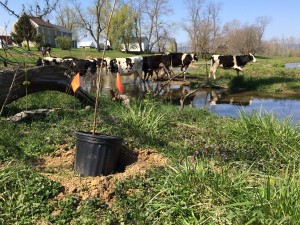 Stream Link Education, along with 25 volunteers planted along one side of Glade Creek, noting that cows still have access to the creek on the other side! We have learned that the landowner on the other side is working on fencing out the cows and is interested in stream buffer restoration as well. Great news! Glade Creek is a tributary to the Monocacy River, a drinking water source for Frederick City residents.
]]>
Stream Link Education, along with 25 volunteers planted along one side of Glade Creek, noting that cows still have access to the creek on the other side! We have learned that the landowner on the other side is working on fencing out the cows and is interested in stream buffer restoration as well. Great news! Glade Creek is a tributary to the Monocacy River, a drinking water source for Frederick City residents.
]]>April 23rd: get some photos of stream bank erosion, free pizza and a t-shirt
A new campaign to raise awareness about how sediment can affect water quality has launched in Frederick County. “Is This Erosion?” encourages community members of all ages to use a website and mobile phone application to share your photos of places where stormwater runoff is wearing away banks and depositing sediment into rivers and streams. Friends of Frederick County (FoFC) is calling on volunteers to participate in celebration of Earth Day 2016! Show us your photos, win a free t-shirt and join others for pizza and to share your photos! We will use your photos to help us determine stream protection actions to take, such as riparian plantings.
“River and stream erosion can degrade the quality of our drinking water and deprive fish, frogs and other animals of the habitat they need to live,” said Brent Walls, Upper Potomac Riverkeeper. “By participating in the #Isthiserosion? campaign, residents can learn how to recognize erosion and report it to others who can address its effects.”
Water Reporter documents and maps volunteer reports through a simple mobile app and website. Each new report help builds a comprehensive library of observations about the state of rivers and streams, including potential water quality threats or progress at correcting problems. Because volunteers are outdoors at different times and places, they can provide information that environmental groups and government officials can use to monitor river and stream health.
FoFC has had success using this mobile app to alert government officials about water pollution sources, and over 25 have been addressed with cow fencing, silt fencing, tree plantings and stream clean ups. A FoFC partner organization, Stream Link Education (streamlinkeducation.org), raises native tree and shrub seedlings at the Scott Key Center and at Mount St Mary’s University for planting along eroded stream banks throughout the county, and has planted thousands of trees. Now, citizen reports sent through Water Reporter system provide important information on new sites that need vegetation to protect streams from erosion.
RSVP to be on Earth Day Water Reporter Volunteer Team by sending an email to [email protected] and get your instructions on how to participate and where to meet on April 23rd 4-6pm for pizza (note no photos, no pizza!). We need at least ten dedicated volunteers, so engage your friends and family with smart phones to use the app and take some photos. Email us now for instructions.
We need your help!
]]> We’re shipping over over 130,000 tons of it every year to PA at a cost of over $6 M.
We’re shipping over over 130,000 tons of it every year to PA at a cost of over $6 M.
There will be a meeting on Monday Feb. 29 at Winchester hall to summarize findings from recent public forums and guide report preparation. for details see https://www.frederickcountymd.
https://www.frederickcountymd.
Citizen concern about taxpayer funds benefiting private developers paid off last week when the majority of the Frederick County state legislative delegation voted against Stadium Authority bond funding for a proposed hotel and conference center in downtown Frederick. This is a welcome development, and we hope that it leads to a fundamental rethinking of the entire project. Read the letter to the editor.
There are many reasons to be concerned about the way this project has evolved, most notably a troubling lack of transparency in the financing process. But at the root of it all is something more fundamental: our collective inability to imagine Frederick city and as the jewel that is, and could be.
Frederick County has assets that just about any jurisdiction would die for. Hundreds of thousands of acres of open space, woodlands, farmland, mountains and streams. A vibrant, well-preserved and diverse city, with a place in history that is unmatched just about anywhere in the U.S. Sparkling towns and hamlets sprinkled across the landscape, each with its own unique place and charm. Good schools, a solid tax base, low crime.
And yet we seem intent on beating a path toward mediocrity.
The downtown hotel project is the perfect example of this problem, both in the lack of vision for the project and the persistent whiff of political deal-making surrounding it.
We can do better, and we hope that last week’s vote marks a turning point where citizens and elected officials will now work together to set standards of excellence in transparency, integrity, design and vision that serve as a benchmark for future development.
To help us get there, Friends of Frederick County proposes the three simple criteria to measure our success toward that goal as we work together to bring a downtown hotel to Frederick. At a minimum, any hotel project must:
• Not use any taxpayer funds to support private investment, and financing that does involve public assets or resources must be undertaken with full transparency.
• Enhance, not just match, the historic character of downtown Frederick. This means involving Historic Preservation Commission expertise from inception, not as simply another bureaucratic hurdle to be cleared at the end of the project, while using and preserving existing structures in new and imaginative ways.
• Consider the impact on other downtown businesses, restaurants and facilities through an open, transparent, public process.
In the end, we need to imagine the hotel project as one that defines greatness, not just the next thing we are doing. We need to ask ourselves, is this project the absolute best we can do, does it captivate and inspire, does it build on and add to the unique assets and character that downtown Frederick delivers? Is it the cornerstone of a new vision of Frederick as a place that others look to emulate?
When the answer to those questions is yes, we’ll know we’ve hit on the right hotel.
We will see you there.
Kimberly Mellon, board member, Friends of Frederick County
A red algae bloom in Lake Anita Louise, near Lake Linganore, is creating toxins at a concentration more than 15 times the safe limit, according to the most recent test results from the Maryland Department of the Environment.
Residents of the Lake Linganore area noted in December that Lake Anita Louise had developed a reddish color. They helped send water samples to the department in January. When the state Department of the Environment took more samples Feb. 8, tests showed a consistently high concentration of microcystin. Read the full FNP article.
]]>
 The Future of Stream Restoration and Preservation in Maryland
The Future of Stream Restoration and Preservation in Maryland
April 2, 2016
8:30 am – 5:00 pm
Mount St. Mary’s University – Frederick Campus
Program
· Keynote Speaker: Dr. Margaret Palmer, University of MD
· Panel Discussion
· Sessions for citizens/watershed groups/anglers
· Sessions for stream restoration professionals
· Sessions for policy makers, leaders, government officials
Sponsors: Mount St Mary’s University, Center for Watershed Protection, Hood College, Frederick County Office of Environmental Sustainability, Friends of Frederick County, Society for Ecological Restoration, Maryland Department of Natural Resources and Maryland Biological Stream Survey.
]]>
Executive Summary
When the Environmental Protection Agency (EPA) created the Chesapeake Bay Total Maximum Daily Load (Bay TMDL) out of local TMDLs for 92 individual Bay segments in 2010, reactions were polarized. Supporters of Bay restoration hoped this unprecedented, legally enforceable, multi-state approach would break the gridlock and compel compliance with a “pollution diet” that would restore the world-famous estuary from its continued state of degradation and ever-present dead zones. After all, billions of dollars in state and federal funding and decades of previous “cooperative” efforts had repeatedly failed to reach their stated goals, rendering an enforceable TMDL framework the only remaining option. Even opponents of the significant expenditures required to meet the Bay TMDL pollution reduction goals seemed to share the view that this time would be different. As EPA, the seven Bay jurisdictions – Delaware, the District of Columbia, Maryland, New York, Pennsylvania, Virginia, and West Virginia – and the Chesapeake Bay Program began work on implementing the Bay TMDL in 2010, affected industries hurried to the courts, legislatures, and media, seeking to overturn the TMDL and obstruct EPA and state regulators from pursuing their commitments under the new framework. To its credit, EPA vigorously defended the TMDL in federal court, twice triumphing. The agency also deflected the most destructive legislative efforts to undermine implementation of the TMDL. However, EPA has no time to rest on its laurels. Instead, EPA must recognize another, equally potent threat to Bay restoration. The seven Bay watershed jurisdictions are lagging far behind in implementing the Bay TMDL….
Read the report, and the recommendations. In summary, they are:
1. Pennsylvania’s failure to uphold its commitments jeopardizes the entire Bay TMDL.
2. Agriculture is the largest pollution source and the most promising and cost-effective sector for future reductions. Accelerating progress means solving the manure crisis.
3. The Bay TMDL is vital to water quality for communities located far from the Chesapeake Bay.
4. The model is not perfect, but is good enough to show where more progress is needed.
5. Too much Bay pollution is unregulated or under-regulated. States must close this gap.
]]>In March of 2015, the Circuit Court of Frederick County remanded the decision regarding the approval of the Monrovia Town Center development back to the County Council for clarification – to create a “clean” record. The judge concluded after many hours of deliberation, that the timing of the introduction and the subsequent handling of a letter from the Frederick Area Committee on Transportation (FACT) had in fact muddied the record of the development’s approval. His decision to remand was to allow the County the opportunity to create a clean record.
The Council debated for several months about the significance of the FACT letter and the purity of the “record” on which the Board of County Commissioners’ (BOCC) decision was based, finally taking action September 1, 2015. During that time, many of us reviewed, not only the last hearing of the BOCC (where this FACT letter was introduced), but the entire record – hearings, testimony, staff reports, background information, documents submitted by the developers etc., for the time between the initial approval in January 2014, until April 14, 2014, when the BOCC gave final approval for the development as it stands now. We have taken our responsibilities very seriously and have put a great deal of time and effort into our deliberations on this case.
After intensive reflection and discussion, the majority of the Council decided the entire case needed to be returned to the Planning Commission to create a clean record. Since the September decision, the Planning and Permitting Division has worked to develop a timeline and process under which this case would move forward, ensuring that all aspects of applicable county and state laws would be met.
On January 13th, the Planning and Permitting Division Director briefed the Frederick County Planning Commission on the proposed timeline for this project. As part of this process, the Division has undertaken its own independent and updated traffic study. The study will cover 13 traffic locations and has expanded the hours of review from the original study from a few years ago. It is anticipated this study will be completed by late February to early March, 2016.
Once completed, the Planning Division staff will compile a staff report with the updated traffic study as well as the previous application for 1,250 housing units submitted in February 2014 and will present this to the Planning Commission sometime in March. The Planning Commission will then have its public hearing process, make any findings and recommendations, then transmit this information to the County Council for our deliberations and actions.
It is at this time the County Council will undertake and examine the “clean” record and make any determinations through an open and transparent public process.
The Council has been criticized for not voting to “vacate” the zoning on the property, thereby essentially voiding not only the zoning, but also the Developer’s Rights and Responsibilities Agreement (DRRA) and the Letters of Understanding (LOUs). However, after extensive consultations with County Attorneys, it is our understanding that the judge’s remand did not specifically give us that additional latitude, and to do so could subject the county to additional lawsuits, two of which are still pending in court.
Thus we find ourselves where we are today. The developer has decided against actively participating in the process (as stated by his attorney in his response to the Director of the Planning and Permitting Division) and will not be submitting any additional applications or information. Despite this, the Planning Commission will soon begin its process. Should there be any changes in the recommendations or in the final decision regarding the zoning of this property which might stand in conflict with current approvals, the Council has been assured by the County Attorneys that the developer has moved ahead and spent money at his own risk. In other words, no “vesting” can occur when County approvals and permits are based on a decision that is not final or is still subject to further judicial review, as is the case here. Any work on this development that relies on the Planned Unit Development (PUD) zoning is done at the developer’s risk because the PUD zoning is not final and is subject to further Council and court review.
The Council must move ahead with what we can control – we will work with the Planning and Permitting Division to ensure that the record is clean; that there is an open and transparent process and that in the end, the decision is based on data and facts, and the record is without taint. Beyond that, this Council has no ulterior motives and no power over the process of the Planning Commission. We never asked to review this development, nor did we seek to overturn the previous BOCC’s decision on it. The issue has been thrust upon us and we only ask that everyone be patient as we work our way through it. We are proceeding at a very slow and deliberate pace to ensure that the public has a voice; that they understand what is happening, and that in the end, whatever decision is reached, the record is clean and beyond reproach.
Thank you,
from the office of Bud Otis, Frederick County Council President
]]>
 keep our streams clean. We need to know where there are eroded streambanks – and we need citizens to help.
keep our streams clean. We need to know where there are eroded streambanks – and we need citizens to help.
It’s easy. It’s important
for wildlife, drinking water and flood control.
]]>
There’s a new twist in the Monrovia Town Center development. As you recall in 2015, Frederick County Council sent the MTC proposal back to the Planning Commission to restart the project review process, a huge win for taxpayers who want transparency in government and sound planning based on facts.
However, the developer is making a mockery of the Council’s decision by moving ahead with the process without approval. We believe their strategy is to invest enough that stopping them would elicit their cries of having already spent a lot of money, pity on them will follow and the MTC development would be allowed to move ahead. That is, DESPITE both the public outrage and the council’s decision for sound planning review.
What can we do? Let the Council know that you don’t like what you see!
Please write to the Frederick County Council and ask them to vacate the residential zoning on the property until the proposal has been through the official county revue process. Here is a sample letter which you can copy, edit and sign and send by e-mail:
Send by email.
TO: [email protected], [email protected]
CC: [email protected]_
Dear Council President Otis and fellow County Council members:
I support the Frederick County Council’s decision to send the Monrovia Town Center Planned Unit Development (PUD) zoning case back to the Planning Commission for a restart of the review process. However, I am very upset to learn that the developer continues to defy the Council order for them to reapply, and that they are, in fact, steadily moving forward to vest under the PUD zoning approved by the Board of County Commissioners. With every passing day the PUD zoning remains in effect, the developer is given an opportunity to undermine the Council’s well-considered and proper vote to begin a clean process.
I respectfully ask that the Council clarify for the record the implicit intent of its vote last September to vacate the current PUD zoning. I further encourage the Council to take this action at its earliest possible opportunity, as time is of the essence in this matter.
]]>